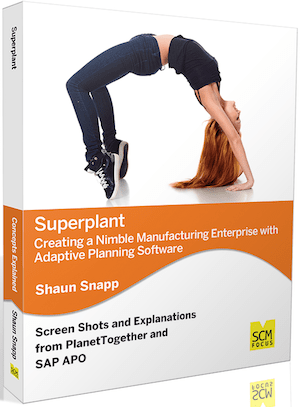 Superplant: Creating a Nimble Manufacturing Enterprise with Adaptive Planning Software
Superplant: Creating a Nimble Manufacturing Enterprise with Adaptive Planning Software
Screenshots and examples from PlanetTogether and SAP APO.
What The Book Covers
In an environment of increasingly globalized manufacturing, a very long production line that spans the globe is more common than ever.
For an increasing number of corporations, multi-plant planning is a reality. “Superplant” describes the ability to plan separate locations as if they were part of one giant plant – or superplant, and is the more accurate modeling of location interdependencies for production and supply planning than is provided by standard advanced planning functionality. This book delves into the three advanced functionalities that must be enabled for superplant planning: multi-plant planning, subcontracting, and multi-source planning.
By reading this book, you will:
- Investigate how multi-site planning works from a design perspective.
- Learn about the functionality that exists to specifically address multi-plant planning and understand why most supply planning software can do nothing with multiple plants.
- Explore in-depth the PlanetTogether application, which targets the unique planning requirements of a superplant.
- Learn how to set up master data objects to support multi-plant planning functionality.
- Improve Key Performance Indicators (KPIs) through proper deployment of multi-plant planning functionality.
- Examine how subcontracting and contract manufacturing fit into the superplant concept.
This book addresses an essential new functionality in production planning. In environments where there are dependencies between products such as when semi-finished goods or components feed a finished good in one factory. Or the components are in a third factory supplying the semi-finished goods plant. I have seen at several companies, then the production across the various plants ends up being not very well integrated. In this circumstance, what has happened is there is one long production line, which is divided between different locations – and in an environment of increasingly globalized manufacturing – a very long production line that spans the globe.
While there are tricks that can be performed – some of which I chronicle in my book Multi-Method Supply Planning in SAP APO — to make the planning systems with a traditional design do the best possible job to integrate these processes. Fundamentally – most supply and production planning software was never designed to meet these requirements. This is because most supply and production planning software in the market is designed to where the supply plan is created first. Few vendors have designed their products to meet a requirement like the multi plant planning or to integrate production and supply planning runs ultimately.
This book attempts to clearly define a specific functionality, which is at the intersection of production and supply planning. It is software functionality that has been known alternatively as “multi plant” or less frequently as “multi-site” functionality, However, the term multi plant, while well known by some of those who are well versed in production planning software, the term has never really struck a cord outside of that relatively small group of individuals. In my informal queries on projects, I have found that the vast majority of those that either manage production planning implementations or work on with production planning software does not know what the term means. However, even for those that have read on the topic, the term multi plant has been diluted by a number of software vendors, the most prominent diluter of the term as has been SAP, which calls functionality which is interplant supply planning and has adopted the term multi plant to describe it. It’s a strange adoption of the term because all supply planning software can source between locations. However, multi plant planning means that the software can both looking inside of the individual plants or factories and choose among alternative routings to make the best decision under a particular scenario or where to produce. The stock transfers that result from this process are a result of the ability to perform comparison across two or more alternative routings. Single plant planning, which is by far the most common design that is used by production planning software, cannot do this, and can only choose among alternative routings within each factory.
Buy Now
Background and Motivation
This book is an attempt to educate readers about the enormous inherent limitations and inefficiencies of the current software approaches
being used to manage the bill of material (BOM). My view of the state of BOM management results from years of working on projects and from seeing companies repeatedly make the same mistakes, costing them in multiple ways. Companies may be affected adversely by the conventional approaches to BOM management in ways such as those listed below:
- Longer product development lead times
- The lower quality final product
- Higher management and coordination costs
- Maintainability issues
- Less efficient internal manufacturing planning
- Reduced ability to leverage or maintain contract manufacturing relationships
The above problems can be significantly mitigated by following the approaches to designing the bill of material management solution laid out in this book. Those who specialize in BOM management system implementation have known these approaches for some time; however, for whatever reason, the information has not caught on with the vast majority of companies.
Chapters
- Introduction
- Understanding the Superplant Conceptually
- Multi-plant Planning
- Single Versus Multi-pass Planning
- Multi-source Planning
- Subcontracting Planning and Execution
- Combining All Three Superplant Functionalities
- The Superplant and the Integration Between ERP and the External Planning System
- Superplant-enabled Capable-to-promise
- Conclusion
Table of Contents
Chapter 1: Introduction
- Books and Other Publications on Superplant Functionalities
- The Origin of the Term “Superplant”
- The Ability to Plan a Single Virtual Plant (for at least some products)
- Future of the Term “Superplant”
- The Applications Showcased in This Book
- PlantTogether as the Superplant Application
- Galaxy APS User Interface Introduction
- Publications on Multi-plant Planning and the History of Method Development
- Different Multi-plant Planning Scenarios
- The Opportunity of Multi-plant Planning
- Subcontracting
- Multi-source Planning
- The Use of ScreenShots in the Book
- Timing Field Definitions Identification
- How Writing Bias Is Controlled at Brightwork Research & Analysis and Brightwork Research & Analysis Press
- The Approach to the Book
- The Brightwork Research & Analysis Site
- Intended Audience
- Abbreviations
- Glossary
- Corrections
CHAPTER 2: Understanding the Superplant Conceptually
CHAPTER 3: Multi-plant Planning
- Who Requires Multi-plant Planning Functionality?
- Understanding the Software Design of Standard Supply and Production Planning Systems
- How Multi-plant Planning Differs from the Standard Designs
- Multi-plant Planning Graphically
- Moving to the Next Stage
- The Criticality of Alternate Paths to the Superplant
- The Logic for Decision Making in a Multi-plant Environment
- Multi-plant Planning Example
- Multi Plant Modeling in Galaxy APS
- Moving Beyond Duration Optimization
- Multi-plant Optimization
- Understanding the Outcomes of Supply and Production Strategies
- The Increased Complexity of the Supply and Production Business Environment
- Multi-plant Planning Versus the Common Manufacturing Trend
- PlanetTogether and Planning the Superplant
- PlanetTogether Questions and Answers
- Conclusion
CHAPTER 4: Single Versus Multi-pass Planning
- “Supply Planning First” Two-Pass Approach
- Single-pass Planning with PlanetTogether
CHAPTER 5: Multi-source Planning
- Multi-sourcing with SAP SNP CTM
- Multi-sourcing with the SAP SNP Cost Optimizer
- Sources of Supply in PP/DS
- Conclusion
CHAPTER 6: Subcontracting Planning and Execution
- Background on Supply Chain Subcontracting
- Choosing Among Subcontractors
- Getting Parts to the Subcontractor Location
- Integrating the Production Planning System with the ERP System for Subcontracting
- Adding an External Supply Planning System
- Conclusion
Chapter 7: Combining All Three Superplant Functionalities
- How Contract Manufacturing Fits into Superplant
- Understanding Optimality
- Superplant Planning and Processing Times
- Conclusion
CHAPTER 8: The Superplant and the Integration Between ERP and the External Planning System
- Multi-plant Planning Integration Issues
- Multi-plant Planning within One Company
- Multi-plant Planning within Two Companies: Manufacturing Orders That Span Financial Entities
- Multi-Source Planning
- Subcontracting and Contract Manufacturing integration to ERP
- Conclusion
CHAPTER 9: Superplant-enabled Capable-to-promise
- CTP
- How CTP Can Be Performed and Integrated with the ERP System
- Cultural Change as Part of CTP
- Superplant CTP
- Performing a CTP Check
- Historical Background of CTP
- Option Overkill
- The Length of the Production Planning Horizon
- Too Much Overhead
- Conclusion
Buy Now
Questions about the Book?
Do you have any questions about the book? If so, please leave us a comment in the message box to the right, and we will address them.
